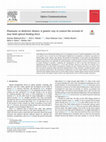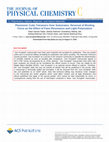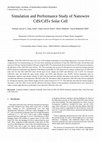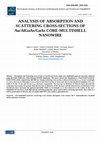Papers by Sakin S Satter

A B S T R A C T Controlling the near field optical binding force is an emerging new area of optic... more A B S T R A C T Controlling the near field optical binding force is an emerging new area of optical manipulation. So far, there is no generic way to reverse the near field optical binding force for plasmonic or dielectric nano-dimers of distinct shapes (cube, cylinder, ring, sphere); and specially for homodimers. In this article, for both plasmonic and dielectric objects, we have demonstrated a general way to control the reversal of near field binding force for different shaped dimer sets applicable for both homodimers and heterodimers. The force reversal is achieved by simple breaking of symmetry, considering the nanoparticles are half or less than half immersed in an inhomogeneous dielectric background, i.e. at air–water interface. However, if the dimer set is placed over a dielectric interface or fully inside a homogeneous medium, the sign of binding force does not reverse. Such force reversals for plasmonic dimers have been explained based on Fano resonance, interference fields, Lorentz force and image charge theory. The mechanism of binding force reversal is quite different in dielectric dimers, which has been explained mainly based on electric dipole moment, magnetic dipole moment and the interaction between electric and magnetic dipole moment. Our proposed idea can be verified by simple experiment.

Near-field optical binding force is an emerging new topic in the field of optical manipulation an... more Near-field optical binding force is an emerging new topic in the field of optical manipulation and
plasmonics. However, so far, all the studies of near-field binding force and its counter intuitive reversal are
only restricted to dimer sets. In this work, we have studied extensively the idea of near- field optical binding
force and associated Lorentz force dynamics for more than two objects, such as plasmonic tetramers over
different substrates. We have demonstrated that if closely positioned plasmonic cube tetramers are placed
only over the plasmonic substrate and circularly polarized light is impinged over them, all-optical control
between their mutual attraction and repulsion is possible due to strong Fano resonance. In addition, the
polarization state of light controls the shifting of the extinction spectra and the binding force
reversal wavelength, making such nanostructures ideal for polarization dependent optical
switching device. The high magnitude of attractive and repulsive binding forces has been obtained at the
dark and bright resonant modes respectively due to strong induced currents in the plasmonic substrate.
Because of its simple arrangement, our proposed tetramer configuration may open a novel route for alloptical
particle clustering, aggregation, and crystallization; which can be verified by the simple
experimental set-up.
Simulation has been done using SCAPS-1D to examine the efficiency of CH 3 NH 3 SnI 3-based solar ... more Simulation has been done using SCAPS-1D to examine the efficiency of CH 3 NH 3 SnI 3-based solar cells including various HTM layers such as spiro-OMeTAD, Cu 2 O, and CuSCN. ZnO nanorod array has been considered as an ETM layer. Device parameters such as thickness of the CH 3 NH 3 SnI 3 layer, defect density of interfaces, density of states, and metal work function were studied. For optimum parameters of all three structures, efficiency of 20.21%, 20.23%, and 18.34% has been achieved for spiro-OMeTAD, Cu 2 O, and CuSCN, respectively. From the simulations, an alternative lead-free perovskite solar cell is introduced with the CH 3 NH 3 SnI 3 absorber layer, ZnO nanorod ETM layer, and Cu 2 O HTM layer.

Thin film CdS/CdTe solar cells has become one of the leading technologies for providing high powe... more Thin film CdS/CdTe solar cells has become one of the leading technologies for providing high power conversion efficiency at comparatively low manufacturing cost. We have done modeling and simulation of thin film CdS/CdTe solar cell and then used nanowire CdS layer instead of planar CdS layer using SCAPS-1D to demonstrate the fact that the use of CdS nanowires enhances the efficiency of the CdS/CdTe solar cells by ~3%. The scattering cross section of CdS nanowire was observed using Lumerical FDTD solutions to determine the preferable diameter for CdS nanowires. For thin film CdS/CdTe solar cell the open circuit voltage was 0.69V and efficiency was 15.42%. For nanowire CdS/CdTe solar cell model the open circuit voltage was 0.82V and efficiency was 18.30%. Device parameters such as: temperature, parasitic series and shunt resistance interface state density, density of states, electron and hole mobility and metal work function were studied which can affect the efficiency of the nanowire-CdS/CdTe solar cell. The rollover effect on nanowire CdS/CdTe solar cell was explained by varying the majority carrier barrier height of back contact from 0.4 to 0.7 eV. This indicates that when the barrier height is increased, a roll over effect occurs and the efficiency decreases.

Absorption and Scattering cross section of Au/AlGaAs/GaAs single core-multishell nanowire has bee... more Absorption and Scattering cross section of Au/AlGaAs/GaAs single core-multishell nanowire has been analyzed using the Finite-Difference Time-Domain (FDTD) simulation. The source used in the simulation is a Total-Field Scattered-Field (TFSF) which ranged from 300-900 nm. Strong scattering cross section (σ_scat) is observed from the σ_scat versus wavelength (λ) curve. Increase in absorption cross section is also observed due to Gallium Arsenide (GaAs) and Aluminium Gallium Arsenide (AlGaAs) having direct bandgaps. For core radii of 25 nm, 35 nm and 45 nm σ_scat increases respectively. The increase in thickness of AlGaAs layer elevated the scattering cross section far greater than the increase in thickness of the Au layer and the joint increase in thickness of the Au/AlGaAs layer increases the spectral linewidth. Shifts in wavelength (λ) is also observed as the radius of the core-multishell NW increases. Such high optical scattering properties can be used in infra-red lasing operations. Since there is a surface passivation of AlGaAs, the core multi-shell NW is also useful as photodetectors.

Cu2ZnSnS4 (CZTS) absorber layer research shows extensive influential factors to replace expensive... more Cu2ZnSnS4 (CZTS) absorber layer research shows extensive influential factors to replace expensive Copper Indium Gallium
Selenide (CIGS) absorber layer due to its high efficiency, low-cost, non-radioactive and environmental friendly behavior.
Potential buffer layers for CZTS solar cells like ZnO, ZnS, In2S3 and ZnSe along with conventional CdS buffer layer are
numerically analyzed. Among these structures, ZnS/CZTS structure shows an optimum efficiency of 26.82% (with Voc = 0.724 V,
Jsc = 53.312 mA/cm2 and fill factor = 69.44 %).This paper explicitly reveals the most favorable CZTS layer thickness around 2.5
μm, whereas buffer layer thickness lies just below 50 nm. Absorber carrier density has its effect on Voc and Jsc and so on
efficiency. With increasing carrier density Jsc decreases while Voc increases. An optimum density of 5×1017 cm-3 to 1×1018 cm-3
shows a great result. The achieved results can lead to the development of higher efficiency CZTS thin film solar cells.
(Avoid the words in abstract Ex. Recently in this work research)
Conference Presentations by Sakin S Satter

DC electrical and magneto-resistive properties of the melt-spun Fe based metallic glass has been ... more DC electrical and magneto-resistive properties of the melt-spun Fe based metallic glass has been experimentally investigated as a function of temperature and magnetic field using the conventional four point probe technique. Measurements were done on both as-made and on annealed samples. Measurements on as made ribbon shaped samples have shown a linear dependence of electrical resistivity and magneto-resistance on temperature and applied magnetic field while some anomalous behavior were observed on the annealed samples. Annealing at high temperature and around the glass transition temperature has presumably resulted in nucleation of some crystallites in the size of nano-meter. Two types of scattering mechanism of the conduction electrons are assumed to be responsible for the anomalous magneto-resistive behavior of the annealed samples . These are the topological disorders being created during fabrication while quenching from the melt from high temperature within a time of microseconds. The other scattering mechanism is the presence of spin scattering centers containing the magnetic elements in the disordered matrix. The ac electrical properties were determined for both annealed and on as-made samples. The complex permeability were measured from 5 Hz. upto 120 MHz. The real part of the ac permeability exhibited a saturation at low frequency with some noisy initial response typical of magnetic met-glasses with elements of 3-d transition metal magnetic elements as the base component. The observed thermal and magneto-electrical properties of the ribbon shaped samples are believed to be suitable for use in low-loss power distribution transformers.
Thesis Chapters by Sakin S Satter
iii Certificate This is to certify that the 4 th year project on "Absorption and Scattering cross... more iii Certificate This is to certify that the 4 th year project on "Absorption and Scattering cross-section analysis of Au/AlGaAs/GaAs core multi-shell nanowire using FDTD simulation" has been submitted for the award of the degree of B.Sc. in Electrical and Electronic Engineering from the University of Dhaka, carried out by exam roll-1238 and exam roll-1258, under my supervision. According to my knowledge and as per declaration, the whole work and project report has been prepared by the student and has not been submitted to anywhere else for any degree. The project report can be considered for evaluation.







Uploads
Papers by Sakin S Satter
plasmonics. However, so far, all the studies of near-field binding force and its counter intuitive reversal are
only restricted to dimer sets. In this work, we have studied extensively the idea of near- field optical binding
force and associated Lorentz force dynamics for more than two objects, such as plasmonic tetramers over
different substrates. We have demonstrated that if closely positioned plasmonic cube tetramers are placed
only over the plasmonic substrate and circularly polarized light is impinged over them, all-optical control
between their mutual attraction and repulsion is possible due to strong Fano resonance. In addition, the
polarization state of light controls the shifting of the extinction spectra and the binding force
reversal wavelength, making such nanostructures ideal for polarization dependent optical
switching device. The high magnitude of attractive and repulsive binding forces has been obtained at the
dark and bright resonant modes respectively due to strong induced currents in the plasmonic substrate.
Because of its simple arrangement, our proposed tetramer configuration may open a novel route for alloptical
particle clustering, aggregation, and crystallization; which can be verified by the simple
experimental set-up.
Selenide (CIGS) absorber layer due to its high efficiency, low-cost, non-radioactive and environmental friendly behavior.
Potential buffer layers for CZTS solar cells like ZnO, ZnS, In2S3 and ZnSe along with conventional CdS buffer layer are
numerically analyzed. Among these structures, ZnS/CZTS structure shows an optimum efficiency of 26.82% (with Voc = 0.724 V,
Jsc = 53.312 mA/cm2 and fill factor = 69.44 %).This paper explicitly reveals the most favorable CZTS layer thickness around 2.5
μm, whereas buffer layer thickness lies just below 50 nm. Absorber carrier density has its effect on Voc and Jsc and so on
efficiency. With increasing carrier density Jsc decreases while Voc increases. An optimum density of 5×1017 cm-3 to 1×1018 cm-3
shows a great result. The achieved results can lead to the development of higher efficiency CZTS thin film solar cells.
(Avoid the words in abstract Ex. Recently in this work research)
Conference Presentations by Sakin S Satter
Thesis Chapters by Sakin S Satter
plasmonics. However, so far, all the studies of near-field binding force and its counter intuitive reversal are
only restricted to dimer sets. In this work, we have studied extensively the idea of near- field optical binding
force and associated Lorentz force dynamics for more than two objects, such as plasmonic tetramers over
different substrates. We have demonstrated that if closely positioned plasmonic cube tetramers are placed
only over the plasmonic substrate and circularly polarized light is impinged over them, all-optical control
between their mutual attraction and repulsion is possible due to strong Fano resonance. In addition, the
polarization state of light controls the shifting of the extinction spectra and the binding force
reversal wavelength, making such nanostructures ideal for polarization dependent optical
switching device. The high magnitude of attractive and repulsive binding forces has been obtained at the
dark and bright resonant modes respectively due to strong induced currents in the plasmonic substrate.
Because of its simple arrangement, our proposed tetramer configuration may open a novel route for alloptical
particle clustering, aggregation, and crystallization; which can be verified by the simple
experimental set-up.
Selenide (CIGS) absorber layer due to its high efficiency, low-cost, non-radioactive and environmental friendly behavior.
Potential buffer layers for CZTS solar cells like ZnO, ZnS, In2S3 and ZnSe along with conventional CdS buffer layer are
numerically analyzed. Among these structures, ZnS/CZTS structure shows an optimum efficiency of 26.82% (with Voc = 0.724 V,
Jsc = 53.312 mA/cm2 and fill factor = 69.44 %).This paper explicitly reveals the most favorable CZTS layer thickness around 2.5
μm, whereas buffer layer thickness lies just below 50 nm. Absorber carrier density has its effect on Voc and Jsc and so on
efficiency. With increasing carrier density Jsc decreases while Voc increases. An optimum density of 5×1017 cm-3 to 1×1018 cm-3
shows a great result. The achieved results can lead to the development of higher efficiency CZTS thin film solar cells.
(Avoid the words in abstract Ex. Recently in this work research)